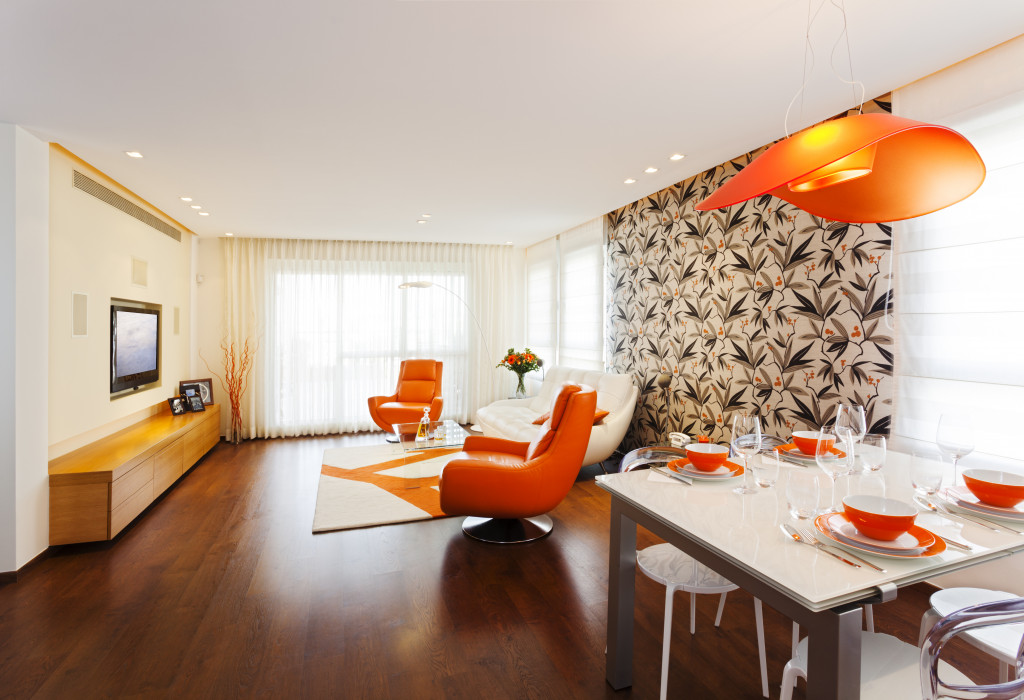Some people don’t enjoy mixing different wood objects in different tones. But the truth is, they work well together. As you can imagine, uniformity can make a room look dull. Mixing up tones is a brave and usually good idea. Wood flooring, furniture, and even wood accents add style to your interior. A mixture of related textures gives your room a little adventurous feel and shows that differences can still make unity.
The same applies to varieties of metals for a great eye-catching interior. Mixing different hues of metal gives your room a unique metallic effect. Your metal supplier can help you if you want to remodel your bathroom and start designing from there. Fabrics also add a sense of variety to your home interior, contrasting durable and light airy material. The key is creativity and the balance of everything. Different textures in your interior add depth to your home style.
Limiting your color palette
Choosing your color palette is the simplest way to ensure your room doesn’t go too dull or overboard. Even if you don’t have to obtain a specific theme, your room can still look coherent with a limited color palette. You can add one or two bright pops of color to give it more life if it’s too neutral. Whatever it is, if you’re not satisfied with it, you can constantly adjust it through little things.
Too many colors in a room can make other features look undeserved, interfering with the overall design. You can repeat the same colors throughout the room to bring items in another room together. It’s also okay to have different color palettes in each room. If you want the color palette in uniform or at least connected according to the color wheel, that’s completely fine too.
Prioritizing the scale
Not paying close attention to the proportion and comparative sizes of the furniture and decors in your room is one of the common mistakes people make when designing the home interior. In one corner of your home, you’ll want to keep the sizes of all your decor and pieces of furniture on the same scale. Otherwise, you might end up settling with an oversized chair or coffee table.
If you think the materials or the colors are your problems that make a room look awkward or just not right, perhaps you’re looking at it all wrong. You might want to notice the sizes of the objects in your space.

Trusting repetition
Repetition works best in any simple design you can think of. Even if you’re in a room with no uniform style, repetition can be the focus of uniformity along with the color palette you’ve chosen. As long as you don’t overdo it, you’ll be fine, whether it’s the materials or the colors.
You can look at repetition in different ways. In lighting, for example, you can repeat two of the same ceiling lamps in your dining area in a row. Three, if you have a long dining table. That’s one way to look at repetition. Another way is doing the same or similar thing in your kitchen. You can set up the same light fixtures above the counters or island where you prepare food. This shows a connection throughout your home.
Choosing an inspiration piece
Aside from a color palette, another aspect that can make the designing process easier is deciding on an inspiration piece within the room. It helps to start even in just one piece and build your interior from there. This can be applied if, for instance, you got your first own apartment and you got your parents’ hand-me-down couch or coffee table. Or maybe you want to remodel, and you don’t want to get rid of a piece of furniture.
In any way, whether it’s a piece of furniture, a light fixture, or a bookcase, you can make it your inspiration and take it from there.
To give an example, you have a wooden coffee table that curves down the edges to its base. You can look into a chair with similar curves to pair with it. Build it up from there, and you can get a ceiling light with a similar design with rounded globes.
The idea of mixing materials to decorate your home can sometimes feel intimidating. It might seem a lot of work (it does), but it’s easier than you imagine. What you need to do first is pick a few different materials that suit your taste and use them around the room. All you need is to look out for balance. Too much of one material can make a room look awkward and bland.
